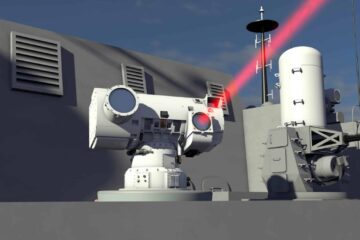The two MROSS vessels will be roled as ‘motherships’ for carrying uncrewed underwater vehicles (UUVs), including remotely operated vehicles (ROVs), that will provide surveillance capabilities to counter the growing threat to critical national infrastructure on the seabed, including cables and pipelines.
The first ship, the Royal Fleet Auxiliary (RFA) vessel Proteus, is completing modification at the Cammell Laird shipyard in Birkenhead, UK. The RN completed the purchase of the ship – formerly the commercial offshore support vessel MV Topaz Tangaroa – in January 2023.
Following completion of conversion work, Proteus will go through a force-generation process in preparation for handover to the RN later in 2023, Commander Alex Goddard, the RN’s MROSS Programme Manager, told the Defence Leaders’ ‘Combined Naval Event 2023’ conference in Farnborough, UK on 25 May.
The original MROSS procurement requirement to counter the emerging critical underwater infrastructure (CUI) security threat was set out in the UK’s 2021 Integrated Review and the supporting Defence Command Paper. International focus on CUI security accelerated in September 2022 following the Nordstream pipelines incident in the Baltic Sea when, according to Western countries and security organisations, the two gas pipelines were blown up by sabotage. That same month, the UK had reached agreement to purchase Topaz Tangaroa, including confirming intended transfer of ownership for January 2023.
In Proteus, the UK has procured a very flexible, very capable vessel very quickly, said Cdr Goddard. The design enables the ship to embark UUVs that can counter CUI threats in shallower waters. Bearing in mind the Nordstream incident, this presents the more immediate threat.
The ship is designed to carry the UUV capability to a given location and then offboard it, Cdr Goddard explained. Delivering this capability is supported by the 1,000 m2 working deck, a ship’s crane, an ROV hangar that spans the width of the ship, and a 7 m by 7.2 m moonpool.
“The ship is very, very flexible – ideal for launching offboard systems”,
Commander Alex Goddard, the RN’s MROSS Programme Manager
In the longer term, the second MROSS ship will bring purpose-built design to enable the operation of deep-water capable UUVs, in blue-water operational contexts, because different, more robust UUVs will be needed for operations at greater depths. RN deep-water CUI protection capability is currently provided by the survey ship HMS Scott, which has been extended in operational service until 2033. To meet this requirement, the UK has options to build the second ship indigenously or to purchase a vessel off-the-shelf.
The RN is currently in the pre-concept phase for developing this capability, said Cdr Goddard.
Giving the ‘Combined Naval Event’ keynote address on 23 May, the RN’s Second Sea Lord Vice Admiral Martin Connell confirmed that Proteus will become operational later in 2023. Moreover, he added, “The UK is being really clear that we’re procuring a vessel that is capable of protecting our sovereign CUI.”
On 25 May, the navy’s First Sea Lord and Chief of Naval Staff Admiral Sir Ben Key visited Proteus at Cammell Laird, posting on social media that the ship “will very soon be delivering vital ocean surveillance capability on behalf of the UK to protect our peace and prosperity”.






